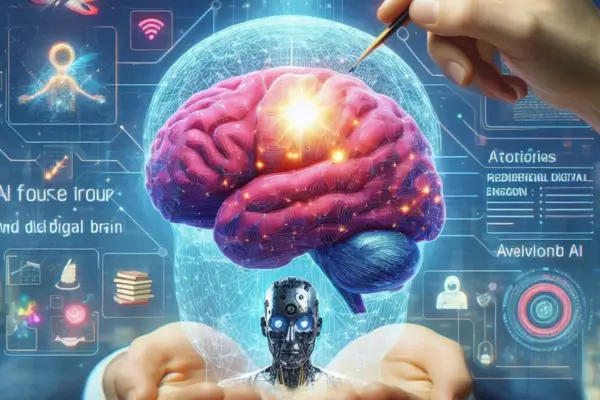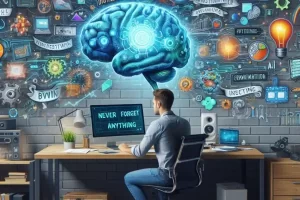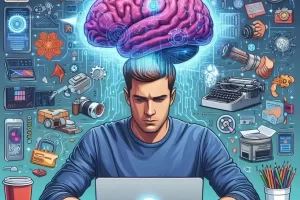A second brain becomes exponentially more powerful when it runs without constant manual effort. While most people use their systems for storing ideas and managing tasks, few take full advantage of automation — especially when combined with artificial intelligence (AI).
In this article, you’ll learn how to automate key workflows in your second brain using AI and no-code tools. This not only saves you time, but ensures that your notes, tasks, and ideas flow into the right places without you lifting a finger.
Why Automate Your Second Brain?
Automation helps you:
- Capture more content with less effort
- Keep your second brain up-to-date automatically
- Eliminate repetitive tasks
- Free your mind for creativity and decision-making
- Maintain consistency across your projects and processes
And with AI in the mix, you can go beyond simple triggers — you can build workflows that summarize, organize, and prioritize information intelligently.
Tools You’ll Need
To automate your second brain effectively, you’ll need:
- AI Assistant: ChatGPT, Notion AI, or a custom GPT
- Main Workspace: Notion, Obsidian, Tana, or Mem
- Automation Platform: Zapier, Make.com (Integromat), or natively supported integrations
- Capture Tools: Readwise, Otter.ai, email, calendar, voice notes
These tools work together to collect, process, and organize your knowledge while you focus on deep work.
Workflow 1: Auto-Save and Summarize Highlights
📘 Goal: Automatically save and summarize highlights from articles, books, and podcasts.
Tools: Readwise → Notion + ChatGPT
Steps:
- Connect Readwise to your note app (e.g., Notion or Obsidian).
- As you highlight content, it syncs into your “Highlights Inbox.”
- Use ChatGPT to auto-summarize each batch weekly: “Summarize these highlights in 5 key points and suggest 3 tags.”
✅ Now, you build a searchable summary library from all your reading — without lifting a finger.
Workflow 2: Auto-Categorize New Notes
🗂️ Goal: Send notes or journal entries to the right folders with smart tags.
Tools: Notion AI or Tana + Zapier
Steps:
- Add new notes to a “Capture” database.
- Use Notion AI or an automation script to analyze the note and apply tags like “Mindset,” “Productivity,” “Writing,” etc.
- The note is then automatically moved to the correct project or resource folder.
Prompt to use:
“Analyze this note and assign it to a category. Also, extract any actionable steps.”
✅ No more sorting through folders — AI organizes your thinking for you.
Workflow 3: Auto-Create Tasks from Notes or Meetings
📝 Goal: Generate actionable tasks from meeting notes or journal entries.
Tools: Otter.ai + Notion + ChatGPT or Tana
Steps:
- Record a meeting with Otter → transcript is saved.
- Paste transcript into ChatGPT: “Extract all action items and assign deadlines based on context.”
- Create new tasks in your task database and link them to relevant projects.
✅ This saves hours each week and ensures no action item is forgotten.
Workflow 4: Daily Briefing with AI
📅 Goal: Start your day with a summary of tasks, meetings, and important notes.
Tools: Zapier + Notion or Mem + ChatGPT
Steps:
- Schedule a daily automation to run every morning.
- Pull tasks due today, today’s calendar events, and any new notes.
- Ask AI: “Summarize today’s priorities, meetings, and tasks. Suggest a top 3 focus list.”
✅ You open your second brain and everything you need is ready — automatically.
Workflow 5: Weekly Review Automation
🔁 Goal: Summarize your week and prep for the next.
Tools: Notion AI + ChatGPT + calendar integration
Steps:
- Every Friday, trigger a review automation.
- Compile tasks completed, new notes, and events from your calendar.
- Prompt: “Generate a weekly summary with wins, challenges, unfinished tasks, and next week’s priorities.”
✅ A frictionless way to reflect, learn, and plan every single week.
Workflow 6: Save and Organize Voice Notes
🎤 Goal: Convert voice ideas into notes and tasks instantly.
Tools: Otter.ai or voice recording app + Zapier + ChatGPT
Steps:
- Record voice note → transcription via Otter.
- Zapier sends transcription to ChatGPT.
- AI summarizes and classifies it (e.g., “Idea,” “Reflection,” or “Task”).
- Sends it to the right place in Notion, Obsidian, or Mem.
✅ You can now think out loud and still stay organized.
Workflow 7: Email to Second Brain
📩 Goal: Send valuable emails (newsletters, client info, etc.) directly into your second brain.
Tools: Zapier + Gmail + Notion or Obsidian
Steps:
- Tag or star an email in Gmail.
- Zapier detects it and forwards content to your note app.
- AI summarizes and suggests tags or links.
✅ No more copy-pasting — your most important communication becomes part of your thinking system.
Workflow 8: Idea Resurfacing and Reuse
🔁 Goal: Make sure old ideas don’t get buried.
Tools: Notion, Tana, Mem + AI
Steps:
- Set a weekly or monthly prompt: “Surface 5 ideas from my Idea Vault I haven’t used in 90 days.”
- Ask ChatGPT: “Can any of these ideas be repurposed for my current project?”
- Add to current projects or publish queue.
✅ This keeps your second brain alive and creative, not just an archive.
Real-Life Example: Automations for a Busy Professional
Let’s say you’re a coach or consultant. With these automations, you can:
- Auto-capture client notes and tag them
- Turn coaching calls into tasks
- Summarize the week’s client activity
- Track content ideas and repurpose them
- Prepare each day and each week without lifting a finger
You’ve just saved hours — and improved consistency across your entire knowledge system.
Final Thoughts: Let Your Second Brain Run Itself
Your second brain shouldn’t rely on your memory to stay organized. With automation and AI, it becomes a living, self-managing system — capturing insights, structuring information, and surfacing what matters most.
Start with one or two workflows. Build slowly. Let AI handle the maintenance, so you can focus on thinking, creating, and growing.
You don’t need to be everywhere. Your second brain — powered by automation — works even when you don’t.




